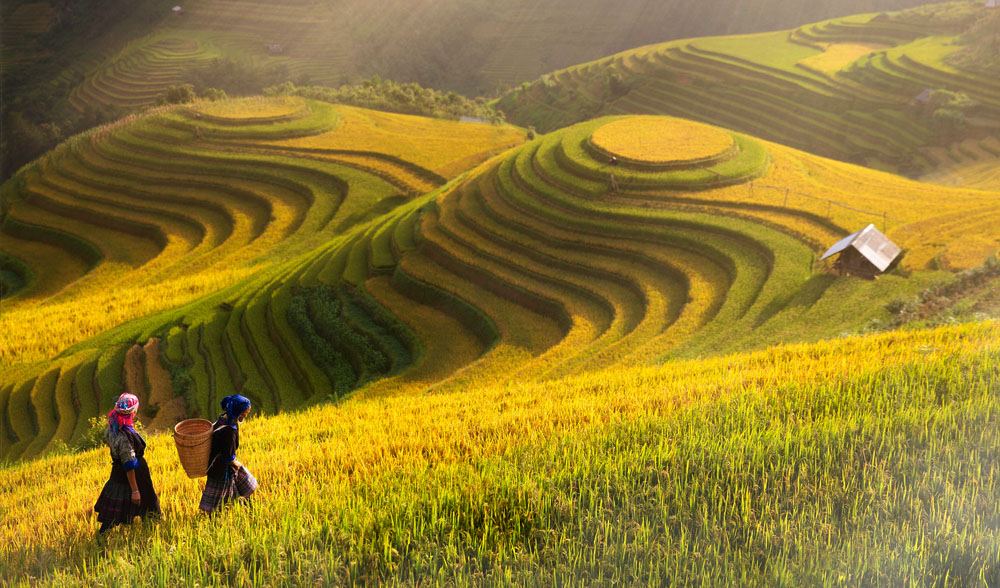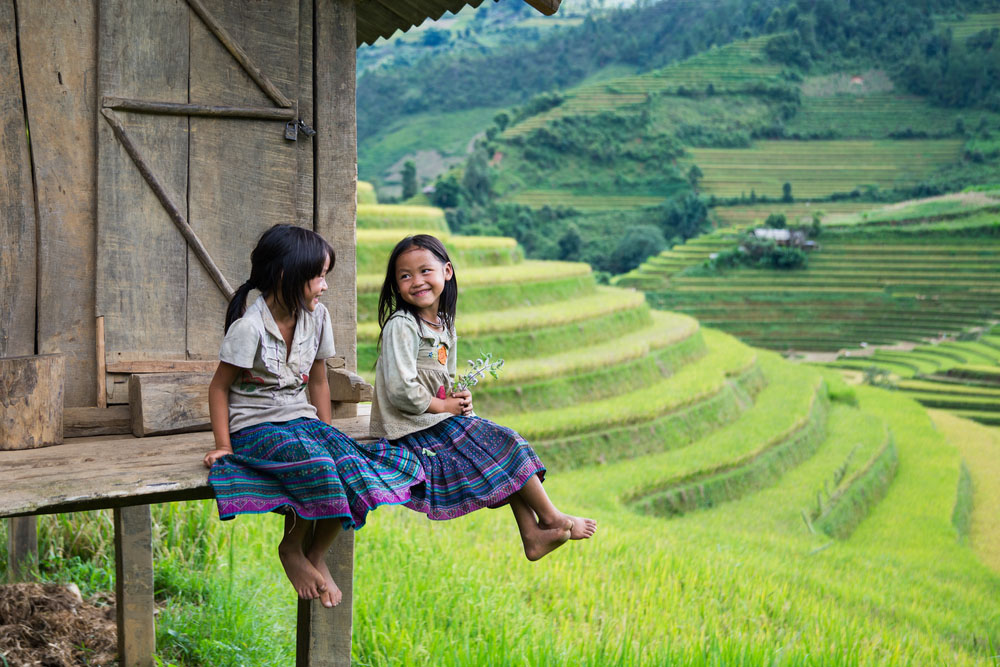The ripe rice period is from September 15 to October 20, but it also varies from year to year. You can ask the local experts of Asiatica Travel to ask about the situation of the rice field, or search for more information from travel forums. If you can not wait until the ripe rice season, you can go around May 5, when the H’Mong people discharge the water, gazing at the flooded rice fields that reflect the sun is also gorgeous.
You can travel by motorbike or private car to Mu Cang Chai, following these routes to get to Mu Cang Chai:
– Via Son Tay, Trung Ha and Tam Nong bridges, keep on the banks of the Red River, and go to Van Phu and Yen Bai bridges.
– Thang Long Bridge, NH2, Phuc Yen, Viet Tri, Doan Hung, NH70 straight to Yen Bai (easiest to go, nearest).
– Thang Long Bridge, Phuc Yen, Vinh Yen, Lap Thach, Son Duong, NH37, Tuyen Quang, and Yen Bai.
If you want to travel by coach, every day, there are cars from My Dinh station to Mu Cang Chai.
The distance from Hanoi to Mu Cang Chai is about 280km, if traveling by car it will take a day. You can take a rest in Tu Le or Mu Cang Chai town, relax and walk around Nui Pho. On the second day, you can spend all day wandering the terraces. Areas that have beautiful rice fields are Tu Le and La Pan Tan communes. Arriving at La Pan Tan commune, you can then walk through high mountains to unleash your eyes to see.

Option 1
Day 1: Moving from Hanoi to Nghia Lo with a distance of 189km and spending the night in Nghia Lo town (Muong Lo).
Day 2: Ride to explore the beautiful scenery at Khau Pha pass, Lung Mong valley, La Pan Tan. Overnight at Mu Cang Chai
Day 3: Back to Hanoi
Option 2
Take the train to Sapa in the evening, on the second-day drive to Mu Cang Chai about 200km from Lao Cai (the train arrives at Sapa at around 5h-5h30). If you go early, you can have lunch and play in Mu Cang Chai in the afternoon of the second day. Return to Hanoi on the third day. This plan will be more difficult because travel to Sapa by night train may cause insomnia.
Lung Mong village Cao Pa commune, Mu Cang Chai district – Yen Bai has been hiding in the clouds for ages. Until now, people moved often whispering to each other in the Northwest because of the difficulty of the road and because it is also the place … the end, and Lung Mong is one of them, full of invitation. Call and also challenging.
Khau Pha Pass: Is one of the four great peaks of the pass in the North and is the longest pass with an altitude of over 40km. On the Khau Pha pass, there is often cloud cover to the sky. Pass bend the amount of zigzag around the identical scallops mountain range, the car between the great forest.

Considered a tourist destination not to be missed when traveling to Mu Cang Chai, where you will admire the terraced fields stretching in beautiful green and yellow. When you come here you can visit Lung Thai and Lung Mong villages about 3km away and see the stilt houses on both sides of the road.
La Pan Tan terraced fields: The most abundant terraced fields in Mu Cang Chai with 700 ha of terraced fields. With cascading terraced fields, layers spread across the hill, especially here are the famous raspberry fields and attract tourists to visit and take pictures.Che Cu Nha Commune
A commune of Mu Cang Chai District, located about 7 km from the center of the district towards Hanoi, the road to this commune is quite steep and difficult to access, not suitable for first-time visitors.
Pu Nhu waterfall: Located in Pu Nhu village, in La Pan Tan commune, Mu Cang Chai district, about 10km west of the center of Mu Cang Chai district. Originated from streams in the watershed forests coming from Than Uyen (Lao Cai), the waterfall has a height of about 20m and is divided into steps.

Pass the bridge in the center of the district (toward Che Tao) and turn left for about 1km to reach Thai village. A small, peaceful village in the middle of the valley, leaning against the mountain.
Hill tribes pork
Pigs raised in Mu Cang Chai villages are black pigs. The Mong people raise this black pig in a rudimentary and wild method. Pigs are raised freely in the garden or on hillsides behind the house. There is no barn, no special care, pigs mainly eat food available in the garden or on the hill such as forest vegetables, corn, potatoes, cassava so the meat is firm, fragrant and low in fat.
Hill chickens
Like hill tribal pigs, hill chickens are naturally raised on the hillsides behind the houses. Their meat is firm, delicious, fat-free, quite small chickens are just over 1kg /each. If you want to eat, you should order from the previous night, the host catches the chicken and locks it up then cook in the next morning. If it is late, it is difficult to catch the chickens because the next morning they are left on the hill.
Tu Le sticky rice
If you come to Tu Le or other areas of Mu Cang Chai during the ripe rice season, you absolutely must not miss the sticky rice, cooked from rice grown on terraced fields. You should order the host to cook a new sticky rice dish (newly harvested rice). It is very flexible and fragrant; after cooking, it is still a little mushy because the new rice contains a lot of water. If you eat sticky rice but it is a bit hard and dry, you are probably eating rice harvested from the previous year.

Wild bee pupa
Stir-fried bee pupas are delicious, must not be too crushed, and remain the shape of the bee pupas, and the Indian taro must be light green. The dish has a rich aroma of bees, spices, and lemon leaves. Stir-fried bee pupas are not available in every season but in the season of bee nesting and breeding (from April to August). So for the people here, this dish is also considered a rare specialty of the mountains.Five-colored sticky rice
A popular dish for the Tet holiday or festival of the Northwestern highlanders. The unique feature of this sticky rice is the use of natural ingredients to dye the sticky rice. To cook this dish is quite sophisticated so this dish is not popular that local people only cook for holidays. If you want to try this dish, you need to order in advance for the host to prepare.
Kitchen-hanged pork/buffalo meat
These are the special dishes of the black Thai people. This dish is usually made from the muscles of buffaloes left freely on the mountains and hills. When processing, people remove the fibers into pieces, then smoked with the smoke of charcoal burning from the trees growing on rocky mountains.

Muong Lo roasted grasshoppers
There are many ways to make delicious dishes from grasshoppers. However, the crispy fried grasshopper is still a favorite food of the people here. Well-roasted grasshoppers are dark yellow, very fragrant. On the other hand, braised grasshopper dish with sour bamboo shoots (or rice vinegar) on a simmer.
Bamboo shoots and forest vegetables
Bamboo shoots are small, about the size of a sickle, white and yellow. In the right season, young bamboo shoots are easy to peel, sweet, and fragrant when boiled.
Mr. Don’s homestay
Mr. Doi’s Homestay
You just go to Mu Cang Chai town and ask local people for their names and address.